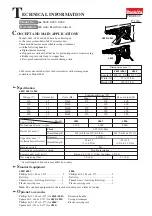
FL-PS Series Instruction Manual —
P/N LS10227-001FL-E:B 3/29/2021
31
Section 5: Trouble Supervision
The FACP will detect FL-PS power supply faults. Any of the following conditions will cause the trouble contact to open, provided the
FACP Notification Appliance Circuit is
not
in alarm.
5.1 Trouble Supervision Using Input Circuits
The FACP (Fire Alarm Control Panel) supervises the connection between itself and the FL-PS via the control panel’s NAC End-of-Line
Resistor (ELR). To supervise the FL-PS, an ELR must be installed across terminals 1 & 4 of Command Inputs #1 and #2 (and #3 for the
10 amp models). A field wiring fault on the NAC output of the FL-PS will trigger a disconnection of the ELR at the related Command
Input, causing a general NAC trouble at the FACP provided the FACP’s NAC is
not
in alarm. Refer to Section 3.2, “Output Circuit Con-
trol DIP Switch Settings”, on page 25 for input/output configuration assignment. The following are exceptions.
1.
Resettable Aux Power, Non-Resettable Aux Power, and Door Holder Aux Power outputs that trigger the Trouble relay during an
output trouble instead of breaking the ELR connection at the Command Input regardless of the output to input relationship (i.e.
mapping). Refer to 5.2, "Trouble Relay" below.
2.
Faults are only reported by Command Input #1 when Selective Silence output mode is controlled by Command Input #1 and #2.
3.
Faults are only reported by the trigger input when Command Input #1 is configured for Sync Input mode operation controlled by a
sync and trigger input.
If the FL-PS is in alarm, only a short circuit on the NAC will be detected as a trouble.
If other trouble monitoring is required when the power supply is in alarm, the Trouble Relay at TB1, and AC Trouble at TB2, and
Ground Fault Trouble at TB3 (Canadian applications only) can be used for this purpose.
5.2 Trouble Relay
The FL-PS power supply has a fail-safe Form-C trouble relay located at TB1. The contacts can be monitored by an FACP input circuit or
an addressable monitor module as illustrated in Figure 5.1. Note that any faults reported by Command Inputs are not repeated by the
trouble relay, offering limited trouble reporting.
Trouble conditions that will cause the normally energized trouble relay to change states regardless of whether the panel is in alarm or
standby:
• A battery fail condition at the power supply
• A battery charger fail on the power supply
• A ground fault condition on the power supply (non-Canadian models only)
• A field wiring fault on the FL-PS output in Resettable Aux Power, Non-Resettable Aux Power, or Door Holder Aux Power mode
• A total panel overload fault
If trouble monitoring is required when the power supply is in alarm, the Trouble Relay at TB1 can be used for this purpose. Refer to
Figure 5.1 below.
5.3 AC Trouble Relay
The FL-PS power supply has a fail-safe Form-C trouble relay located at TB2. The contacts can be monitored by an FACP input circuit or
an addressable monitor module similar to the drawing illustrated in Figure 5.1. The AC Trouble Relay responds to an AC fail condition
on the FL-PS immediately, or after a programmed delay time, depending on the setting of S1 switches 7 and 8.
The reporting of AC loss to a central station is usually delayed in order to prevent multiple transmissions of AC loss and restoral, allow-
ing AC power to stabilize. When a host FACP is programmed to delay AC loss reporting, the FL-PS must be configured to delay the
reporting of AC fail. This is accomplished by setting S1 positions 7 and 8. Refer to the DIP switch setting chart in Table 3.5 on page 24.
This will prevent AC loss from being reported as a trouble condition for 30, 12, 2, or 0 hours. Note that only no delay and the 2 hour
delay are acceptable per UL 864 and UL 2572.
NOTE:
The individual NAC Trouble LED will indicate which NAC circuit is in trouble.
NO NC C
NO NC C
TB4
T
B
2
T
B
1
T1
T11
T2
T10
T3
T9
T4
T8
T5
T7
T6
NO NC C
T
B
3
SLC
Monitor Module*
FL-PS6/10C
T7
T6
NC
C
*If the SLC device does not match the
one in this figure, refer to the SLC man-
ual wiring conversion charts for legacy
and newer versions of the modules.
AC
Trouble
Trouble
Trouble Relay
Figure 5.1 Monitoring the Trouble Relay
TB3 is only populated
on Canadian models.
Monitor Module ELR
















































